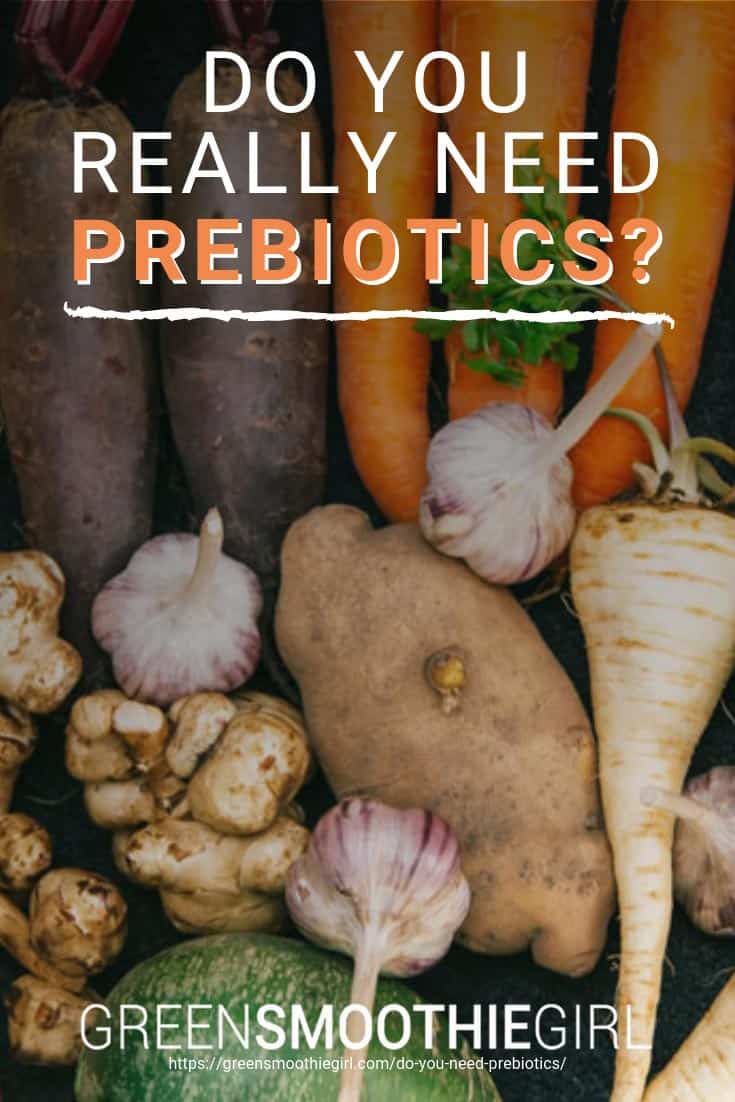Do You Really Need Prebiotics?
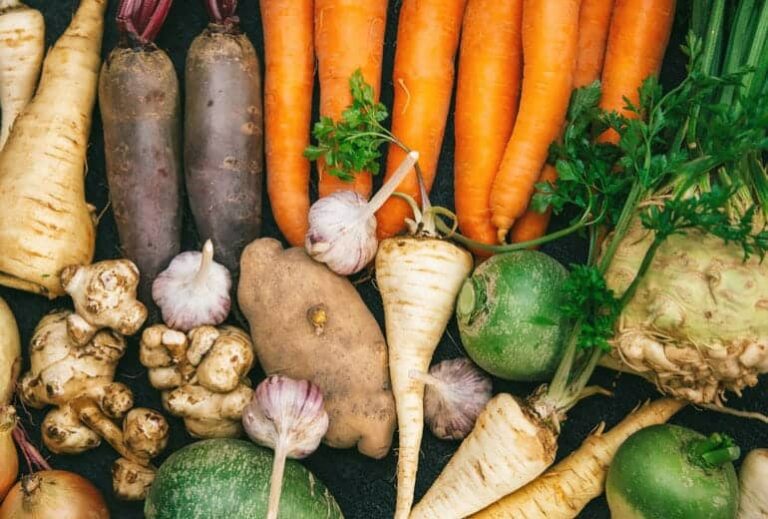
When it comes to digestive health, probiotics usually steal the show. And with good reason. Your gut bacteria are responsible for everything from hormone regulation1 to immune health2. But what about prebiotics? Is that even a thing?
The answer is yes.
In this post:
- What Are Prebiotics?
- Prebiotics Vs. Probiotics
- Can You Take Prebiotics and Probiotics Together?
- Benefits of Prebiotics
- Choosing the Right Probiotic for Your Prebiotic
- Prebiotic-Rich Foods, Prebiotic Fiber, and Supplements
- The Best Sources of Prebiotic Plant Fiber
- What About Prebiotic Supplements?
- When and How to Take Prebiotics
Think of prebiotics as the wind beneath your probiotics’ wings. Or, more accurately, the fuel your microbiome of gut bacteria needs to flourish.
Here’s what you need to know about this unsung digestive hero.
What Are Prebiotics?
As living organisms, the bacteria in your gut need food. And they need a specific kind of fuel to do their job right: fermentable dietary fiber, aka prebiotics.
Fermentable dietary fiber isn’t digested. Instead, this prebiotic fuel passes right through the stomach and on to the intestines, where your microflora ferment it into short-chain fatty acids3 that reduce inflammation, protect you from disease, and help regulate your hormones.
Prebiotics vs. Probiotics
Probiotics are the magic bullet you’ve been hearing about in everything from yogurt commercials to scientific journals. Like the name implies (“pro” means “for,” while “biotic” means “life”), probiotics are living organisms that are vital to maintaining your physical and mental health.
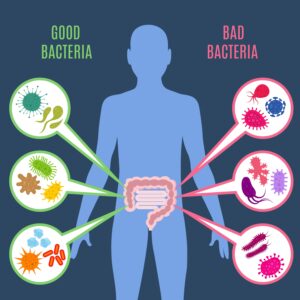
Probiotics in your gut form a thriving, interconnected community comprising trillions of bacteria. But don’t get queasy--those bacteria are supposed to be there.
Probiotics in your gut form a thriving, interconnected community comprising trillions of bacteria. But don’t get queasy; those bacteria are supposed to be there. They’re hard at work digesting food, keeping blood sugar levels in check,4 producing and regulating hormones, and even protecting you from disease. A dense, healthy army of good bacteria actually provides protection from harmful bacteria.
If you wipe out your microbiome with a dose of antibiotics (which literally means “against life”), bacteria like streptococcus can waltz right in and multiply, unchecked. If that same strep bacteria tried to make its home in a healthy gut, it’d be attacked (and probably destroyed) by your friendly neighborhood flora.
Prebiotics, on the other hand, aren’t alive. They’re the specific fuel (fermentable dietary fiber) your gut flora uses to stay healthy,5 multiply in number, and produce those critical short-chain fatty acids.
Interesting fact: Prebiotics are so important, they’re actually present in breastmilk6 to fuel and protect babies’ developing microbiome. Formula companies now add a prebiotic to their products!
Can You Take Prebiotics and Probiotics Together?
You can and should take prebiotics and probiotics together. The healthiest diets are rich in prebiotic foods (more on prebiotic-dense foods below), and the best probiotic supplements include high-quality prebiotic fuel.
Why? Because if you’re fortifying your gut bacteria with a probiotic, but not giving that army of bacteria the fuel it needs, a couple of bad things can happen.
First of all, your microbiome won’t be able to operate like it should. You’ll have less productive bacteria that’s slow to multiply, sluggish, and may even die.
Second, some of the strains of bacteria in your gut are what gastroenterologist Purna Kashyap calls “opportunists”7. Without proper fuel in the form of prebiotics, he explains, “They’ll try to find nutrients elsewhere—and could go after the mucus lining of your intestine,” opening the door for all kinds of inflammation and infection.
Benefits of Prebiotics
The benefits of taking a prebiotic along with your probiotic shouldn’t be underestimated. After all, if you’re dedicated to improving the health of your digestive tract and fortifying your gut with a diverse, vibrant community of bacteria, but you don’t provide any of the fuel your microbiome needs, you’ve just effectively negated many of your probiotic benefits.
Prebiotics give the bacteria in your gut the necessary raw materials to properly multiply, produce those magic short-chain fatty acids, and do all of the following:
- Regulate your hormones (did you know that your gut produces 90% of your serotonin?8)
- Fortify your immune system against disease and infections
- Maintain a healthy weight and metabolism9
- Decrease allergies10
- Reduce inflammation11
- Improve your mental health and mood
- Remove waste effectively from the body
- Cut down on bloating and flatulence
- Protect you from cancer12
- Improve Irritable Bowel Syndrome and regulate your bowel movements
- Promote clearer, healthier skin
- Stave off osteoporosis by helping you absorb calcium more effectively13
- Improve your heart health14
- Improve your sleep quality15
None of these incredible probiotic benefits are possible without prebiotic fuel. And while many people’s diets include some prebiotic foods (like yogurt or cabbage), it’s important to be as diligent about your prebiotic as you are about your probiotic.
Choosing the Right Probiotic for Your Prebiotic
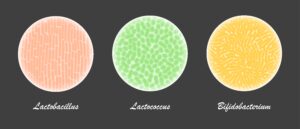
Probiotic bacteria cultures under a microscope: lactobacillus, bifidobacterium, and lactococcus. All useful microorganisms for proper intestinal microflora and healthy nutrition.
First things first: Despite those compelling Activia commercials, many products advertised as probiotics aren’t actually what they seem (case in point: all those successful lawsuits against Dannon that revealed far fewer live probiotic cultures than advertised).
Heat treatment kills bacteria, meaning that while a particular food at the grocery story might advertise “live and active cultures,” all it means is that cultures were once alive and active. And even probiotic foods with live cultures are often very limited in bacteria diversity or quantity.
The easiest (and most consistent) way to ensure you’re fortifying your microbiome with a diverse, robust, and living army of bacteria is to take a high-quality probiotic supplement.
Look for a shelf-stable, dry-sprayed supplement (that doesn’t require refrigeration) and a guaranteed best-by date. Your probiotic should be made in small batches to ensure freshness, and boast billions of active organisms per capsule, in a dozen or more strains.
Prebiotic-Rich Foods, Prebiotic Fiber, and Supplements
Plant fiber is the absolute best source of prebiotic fuel for your gut bacteria. Our bodies were quite literally built for processing fiber-rich plant material as the bulk of our diet, a fact that’s highlighted by our digestive system itself.
Carnivores like tigers have straight, short digestive tracts, allowing meat to pass through quickly. Herbivores and omnivores (like horses, monkeys, and humans) have very long, coiled digestive systems that can take upwards of 40 hours to process food.
Why? So your microbiome has plenty of time to extract prebiotic fiber from plant foods and use it to create short-chain fatty acids.
The Best Sources of Prebiotic Plant Fiber
There’s a huge variety of foods that provide prebiotic fiber to your 30 to 35 feet of GI tract, where your “microbiome” lives. All of them are high in soluble fiber, as well as inulin and oligosaccharides (plant-based carbohydrates that your gut bacteria love).
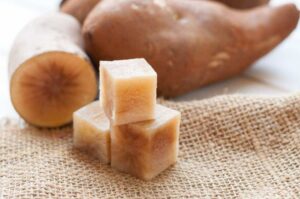
Yacon is a tuberous plant native to the Andes and is one of the absolute best sources of prebiotic fiber!
If you’re looking for the king of prebiotic fiber sources, yacon wins, hands down. This tuberous plant is native to the Andes and is one of the absolute best sources of prebiotic fiber, inulin, and a special kind of carbohydrate called fructooligosaccharide, or FOS (fructooligosaccharides aren’t present in a lot of food sources naturally).
While yacon hasn’t made its way to most grocery stores in the USA, you can find it in this prebiotic/probiotic supplement.
Other terrific sources of prebiotic fiber include the following:
- Beets, carrots, and other root vegetables
- Chicory root
- Artichokes and Jerusalem artichokes (sunchokes)
- Jicama
- Asparagus
- Garlic
- Onions and leeks
- Beans, lentils, and other legumes
- Leafy green vegetables like swiss chard and kale
- Walnuts and almonds
- Oats and other whole grains like quinoa
- Barley
- Dark chocolate or cocoa
- Corn
- Apples, bananas and other high-fiber fruits
What About Prebiotic Supplements?
You should try to incorporate as many prebiotic and probiotic foods as you can into your diet, naturally. However, realistically, it can be difficult to strike the perfect balance of diverse and plentiful probiotics along with their ideal fuel sources.
Taking a high-quality supplement that includes a probiotic and prebiotic can fill in the gaps that diet alone sometimes fails to deliver, despite our best efforts.
When and How to Take Prebiotics
It’s important to get at least five grams of prebiotic fiber each day. Fill your diet with whole foods that contain soluble fiber, and when possible, try to eat those foods raw. Heat can have a significant impact on the amount soluble of fiber in a given food, so use prebiotic foods in salads, smoothies, and raw snacks whenever you can.
Make it a habit to include prebiotic-rich foods with your probiotic-rich foods (yogurt, kefir, kimchi) to give your gut bacteria the best opportunity to flourish and multiply.
Taking a probiotic supplement that includes prebiotic fiber twice a day is a simple way to make sure you’re getting the right ratio of probiotics to prebiotics. You should take this supplement before or with a meal to maximize its benefit.
Dr. Bernard Jensen’s studies have shown that most Americans have a ratio of 10:1 favoring bad bacteria. However, with a sustained one-two punch from probiotics and prebiotics, it’s more than possible to flip that ratio around, to favor good bacteria and gut health.
Check out my 3-in-1 digestive supplement, PreZymePro. Not only does it have the right type and amount of prebiotic and probiotics you’re looking for, we’ve added digestive enzymes (and the mineral cofactors that trigger them) for total digestive tract support! I couldn’t find the product I wanted on the market, so I created it myself, always in small batches for freshness.

Disclosure: This post may contain affiliate links that help support the GSG mission without costing you extra. I recommend only companies and products that I use myself.
Resources
- Gerard Clarke, Roman M. Stilling, Paul J. Kennedy, Catherine Stanton, John F. Cryan, Timothy G. Dinan; Minireview: Gut Microbiota: The Neglected Endocrine Organ, Molecular Endocrinology, Volume 28, Issue 8, 1 August 2014, Pages 1221–1238, https://doi.org/10.1210/me.2014-1108
- Kau AL, Ahern PP, Griffin NW, Goodman AL, Gordon JI. Human nutrition, the gut microbiome, and immune system: envisioning the future. Nature. 2011;474(7351):327-336. doi:10.1038/nature10213.
- Campbell, Kristina. Breaking it down: Short-chain fatty acids and your health. Gut Microbiota News Watch, 5 APR 2017.
- Liping Zhao, Feng Zhang, Xiaoying Ding, Guojun Wu, Yan Y. Lam, Xuejiao Wang, Huaqing Fu, Xinhe Xue, Chunhua Lu, Jilin Ma, Lihua Yu, Chengmei Xu, Zhongying Ren, Ying Xu, Songmei Xu, Hongli Shen, Xiuli Zhu, Yu Shi, Qingyun Shen, Weiping Dong, Rui Liu, Yunxia Ling, Yue Zeng, Xingpeng Wang, Qianpeng Zhang, Jing Wang, Linghua Wang, Yanqiu Wu, Benhua Zeng, Hong Wei, Menghui Zhang, Yongde Peng, Chenhong Zhang, Science. 9 Mar 2018 : 1151-1156
- Slavin J. Fiber and Prebiotics: Mechanisms and Health Benefits. Nutrients. 2013;5(4):1417-1435. doi:10.3390/nu5041417.
- Yong, Ed. Breast-Feeding the Microbiome. The New Yorker. July 22, 2016
- Sloan, Erica. Prebiotics vs. Probiotics: What's the Difference? Prevention.com, Feb 23, 2018.
- Yano JM, Yu K, Donaldson GP, et al. Indigenous bacteria from the gut microbiota regulate host serotonin biosynthesis. Cell. 2015;161(2):264-276. doi:10.1016/j.cell.2015.02.047.
- Davis CD. The Gut Microbiome and Its Role in Obesity. Nutrition today. 2016;51(4):167-174. doi:10.1097/NT.0000000000000167.
- Marcel Roberfroid, Glenn R. Gibson, Lesley Hoyles, Anne L. McCartney, Robert Rastall, Ian Rowland, Danielle Wolvers, Bernhard Watzl, Hania Szajewska, Bernd Stahl, Francisco Guarner, Frederique Respondek, Kevin Whelan, Veronique Coxam, Marie-Jeanne Davicco, Laurent Léotoing, Yohann Wittrant, Nathalie M. Delzenne, Patrice D. Cani, Audrey M. Neyrinck, Agnes Meheust. Prebiotic effects: metabolic and health benefits. Br J Nutr. 2010 Aug; 104 (Suppl 2): S1–63. doi: 10.1017/S0007114510003363
- Looijer–van Langen MAC, Dieleman LA. Prebiotics in Chronic Intestinal Inflammation. Inflammatory bowel diseases. 2009;15(3):454-462. doi:10.1002/ibd.20737.
- Wang Y, Wu Y, Wang Y, et al. Antioxidant Properties of Probiotic Bacteria. Nutrients. 2017;9(5):521. doi:10.3390/nu9050521.
- Scholz-Ahrens KE, Ade P, Marten B, Weber P, Timm W, Açil Y, Glüer CC, Schrezenmeir. Prebiotics, probiotics, and synbiotics affect mineral absorption, bone mineral content, and bone structure. J. J Nutr. 2007 Mar;137(3 Suppl 2):838S-46S. doi: 10.1093/jn/137.3.838S. Review. PMID: 17311984
- Ettinger G, MacDonald K, Reid G, Burton JP. The influence of the human microbiome and probiotics on cardiovascular health. Gut Microbes. 2014;5(6):719-728. doi:10.4161/19490976.2014.983775.
- Krueger JM, Opp MR. Sleep and Microbes. International review of neurobiology. 2016;131:207-225. doi:10.1016/bs.irn.2016.07.003.
Posted in: 12 Steps To Whole Food, Supplements



